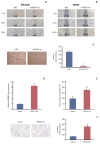Long Non-coding RNA HOXA11 Antisense Promotes Cell Proliferation and Invasion and Predicts Patient Prognosis in Serous Ovarian Cancer
- PMID: 27737536
- PMCID: PMC5512379
- DOI: 10.4143/crt.2016.263
Long Non-coding RNA HOXA11 Antisense Promotes Cell Proliferation and Invasion and Predicts Patient Prognosis in Serous Ovarian Cancer
Abstract
Purpose: The biological function of long non-coding RNAs (lncRNAs) is only partially understood; therefore, in this study, we investigated the expression of the novel HOXA11 antisense (HOXA11as) lncRNA and its oncogenic role in serous ovarian cancer (SOC).
Materials and methods: HOXA11as expression was examined in 129 SOC tissue samples by real time reverse transcription polymerase chain reaction. Clinicopathological factors and patient survival were compared between the high (n=27) and low HOXA11as expression group (n=102). To investigate the role of HOXA11as in cell proliferation, invasion, and migration, HOXA11as expression in ovarian cancer cells was knocked down using RNA interference.
Results: HOXA11as expression in cancer tissue was 77-fold higher than that of noncancerous tissue (p < 0.05). Higher HOXA11as expression was significantly correlated with histological grade (p=0.017) and preoperative cancer antigen 125 (p=0.048). HOXA11as overexpression in SOC cells led to increased cell proliferation, invasion, and migration. Moreover, HOXA11as was associated with the expression of genes involved in cell invasion, migration, and epithelial-mesenchymal transition (EMT), including vascular endothelial growth factor, matrix metalloproteinase 9 (MMP-9), B-catenin, E-cadherin, Snail, Twist, and vimentin. Multivariate analysis revealed that HOXA11as was a prognostic factor of progressive disease and mortality (hazard ratio [HR], 1.730; p=0.043 and HR, 2.170; p=0.033, respectively). Progression-free and overall survival were significantly shorter in patients with high HOXA11as expression.
Conclusion: These findings highlight the clinical significance of HOXA11as to predicting the prognosis of SOC patients and suggest its potential in promoting tumor aggressiveness via regulation of vascular endothelial growth factor (VEGF), MMP-9, and EMT-related mechanisms.
Keywords: Cell proliferation; Long noncoding RNA; Ovarian neoplasms; Prognosis.
Conflict of interest statement
Conflict of interest relevant to this article was not reported.
Figures






Similar articles
-
The clinical significance and biological function of lncRNA SOCAR in serous ovarian carcinoma.Gene. 2019 Sep 10;713:143969. doi: 10.1016/j.gene.2019.143969. Epub 2019 Jul 9. Gene. 2019. PMID: 31299360
-
Gene microarray analysis of lncRNA and mRNA expression profiles in patients with high‑grade ovarian serous cancer.Int J Mol Med. 2018 Jul;42(1):91-104. doi: 10.3892/ijmm.2018.3588. Epub 2018 Mar 23. Int J Mol Med. 2018. PMID: 29577163 Free PMC article.
-
Long non-coding RNA HAL suppresses the migration and invasion of serous ovarian cancer by inhibiting EMT signaling pathway.Biosci Rep. 2020 Mar 27;40(3):BSR20194496. doi: 10.1042/BSR20194496. Biosci Rep. 2020. Retraction in: Biosci Rep. 2021 Sep 30;41(9):BSR-20194496_RET. doi: 10.1042/BSR-20194496_RET. PMID: 32039453 Free PMC article. Retracted.
-
Recent advances in unraveling the molecular mechanisms and functions of HOXA11‑AS in human cancers and other diseases (Review).Oncol Rep. 2020 Jun;43(6):1737-1754. doi: 10.3892/or.2020.7552. Epub 2020 Mar 19. Oncol Rep. 2020. PMID: 32236611 Free PMC article. Review.
-
Long non-coding RNAs as emerging regulators of epithelial to mesenchymal transition in gynecologic cancers.Biosci Trends. 2018 Sep 19;12(4):342-353. doi: 10.5582/bst.2018.01181. Epub 2018 Aug 27. Biosci Trends. 2018. PMID: 30146551 Review.
Cited by
-
Research Progress in Prognostic Factors and Biomarkers of Ovarian Cancer.J Cancer. 2021 May 13;12(13):3976-3996. doi: 10.7150/jca.47695. eCollection 2021. J Cancer. 2021. PMID: 34093804 Free PMC article. Review.
-
Altered long noncoding RNAs and survival outcomes in ovarian cancer: A systematic review and meta-analysis (PRISMA Compliant).Medicine (Baltimore). 2018 Aug;97(32):e11481. doi: 10.1097/MD.0000000000011481. Medicine (Baltimore). 2018. PMID: 30095613 Free PMC article. Review.
-
Microarray analysis reveals differentially expressed lncRNAs in benign epithelial ovarian cysts and normal ovaries.Oncol Rep. 2017 Aug;38(2):799-808. doi: 10.3892/or.2017.5741. Epub 2017 Jun 22. Oncol Rep. 2017. PMID: 28656240 Free PMC article.
-
Long non-coding RNA HOTTIP enhances IL-6 expression to potentiate immune escape of ovarian cancer cells by upregulating the expression of PD-L1 in neutrophils.J Exp Clin Cancer Res. 2019 Sep 18;38(1):411. doi: 10.1186/s13046-019-1394-6. J Exp Clin Cancer Res. 2019. PMID: 31533774 Free PMC article.
-
LncRNAs and the Angiogenic Switch in Cancer: Clinical Significance and Therapeutic Opportunities.Genes (Basel). 2022 Jan 15;13(1):152. doi: 10.3390/genes13010152. Genes (Basel). 2022. PMID: 35052495 Free PMC article. Review.
References
-
- Siegel RL, Miller KD, Jemal A. Cancer statistics, 2016. CA Cancer J Clin. 2016;66:7–30. - PubMed
-
- Menon U. Ovarian cancer: challenges of early detection. Nat Clin Pract Oncol. 2007;4:498–9. - PubMed
-
- Yang G, Lu X, Yuan L. LncRNA: a link between RNA and cancer. Biochim Biophys Acta. 2014;1839:1097–109. - PubMed
-
- Chen T, Xie W, Xie L, Sun Y, Zhang Y, Shen Z, et al. Expression of long noncoding RNA lncRNA-n336928 is correlated with tumor stage and grade and overall survival in bladder cancer. Biochem Biophys Res Commun. 2015;468:666–70. - PubMed
MeSH terms
Substances
LinkOut - more resources
Full Text Sources
Other Literature Sources
Medical
Research Materials
Miscellaneous

